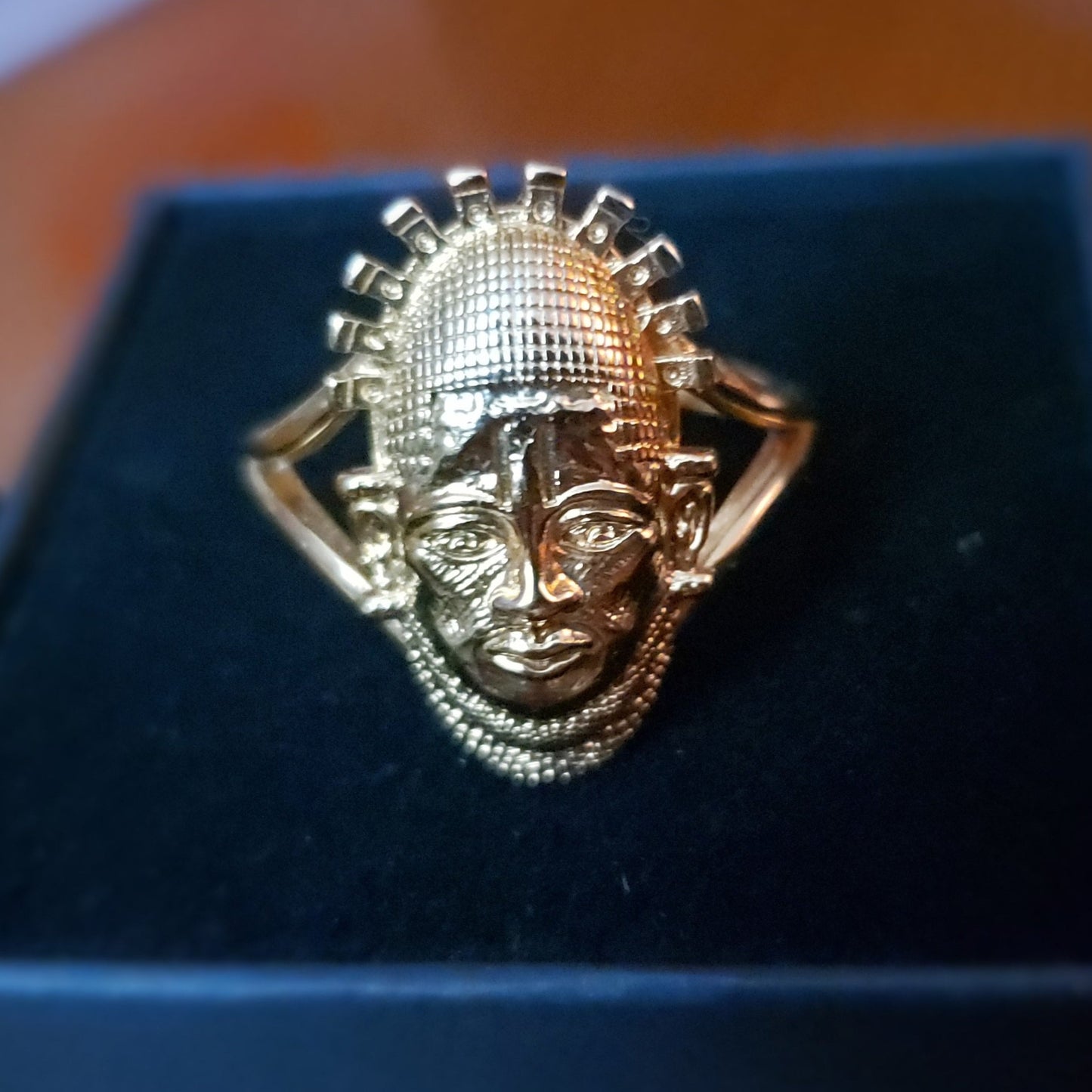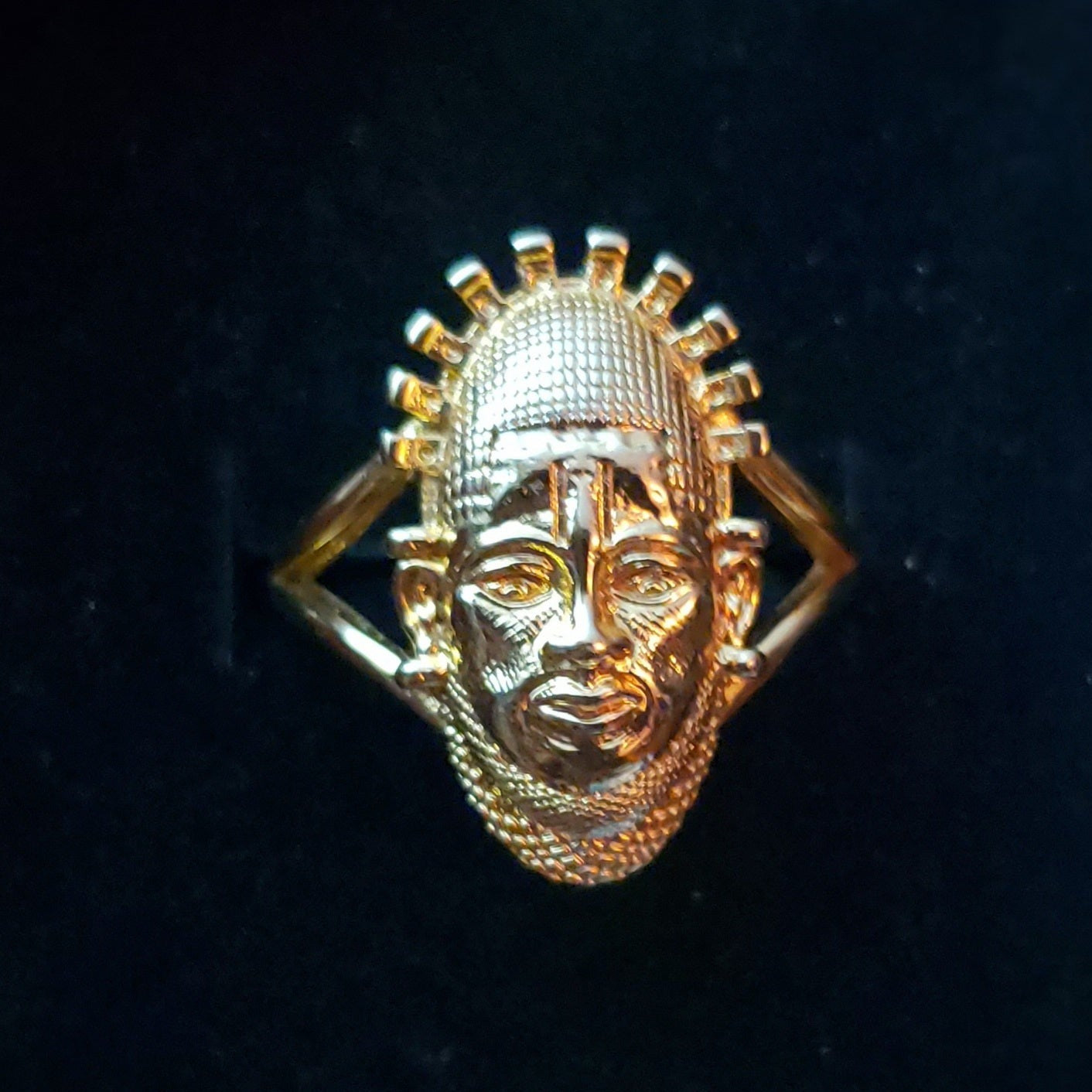AfroCrush
Queen Idia of Benin Empire Ring
Queen Idia of Benin Empire Ring
Couldn't load pickup availability
Adjustable Queen Idia Ring
Pendant is Gold plating on stainless steel
Approximately 2.5 cm long.
Gold plated 18k on a Base metal made of 316L stainless steel
Wont rust or tarnish or corrode
Will not Deform
Hypoallergenic (nickel-free, lead-free)
High polished on the surface, smooth and comfortable to wear
Textured
The original Benin ivory mask is a miniature sculptural portrait in ivory of Idia, the first Iyoba (Queen Mother) of the 16th century Benin Empire, taking the form of a traditional African mask.
Queen Idia is the famous warrior who became even more popular when an ivory carving of her face was adopted as the symbol of FESTAC in 1977.
History:
Mask ORIGINALLY made of elephant ivory, iron, and copper alloy. It was designed to be worn suspended on the chest or hips during important ceremonies by the two large side hoops framing the face.
Queen Mother Idia of Benin is one of the finest ivory carvings from Benin and possibly from all of Africa. It is intricately carved and inlaid to form a sensitive and idealized portrait of a strong noblewoman known to Benin history as Queen Mother/Iy’oba Idia, a warrior queen who led many armies into battle. She aided her son, King/Oba Esigie (r. 1504-50), on his military campaigns and was known locally as “the only woman who went to war.” Idia was therefore highly revered by her son and his people. Oba Esigie commissioned this work and four other ivory pendants to commemorate his strong and powerful mother. These five pendants are similar in style and appearance
afro hair
Below the faces is an intricate pattern of hair. The hair is tightly twisted and forms an almost honeycomb pattern covering the upper-half of Queen Mother Idia of Benin. It adds a geometric element to the naturalist face, and it is strengthened by the clean hard lines of its edges across the forehead. The overall rendering is delicate but powerful, and it celebrates the natural beauty of afro-textured hair.
Scarification
Below the patterned hair are two strong incisions inlaid with iron. They frame the four scar marks above each of the eyes. In 16th century Benin, as in many modern cultures today, scarification is socially accepted and valued. Similarly to tattoos, they are valued by many as permanent body art enhancing its wearer. However, unlike tattoos, scarification in 16th century Benin was only allowed to warriors because it symbolized bravery and strength. Therefore, the scarification of Queen Mother Idia of Benin not only adds interest to her face, but it also declares her military experience and inner character.
Inlaid Eyes
Further below the scarification are the subject’s large eyes. They are wide, heavy-lidded, and almond-shaped. Like the two incisions, the eyes are inlaid with iron too. The pupils, now missing, were originally solid round circles of iron. Both eyelids were also originally inlaid with iron, and when black and polished, would have resembled the famous kohl eyeliner found in ancient Egypt. In its original condition, the black inlays against the white flesh would have dramatically contrasted and heightened the mask’s elegance.
Core Values
It cannot be denied that Queen Mother Idia of Benin is a gorgeous and powerful symbol of a mighty African queen and her kingdom. In many African communities, it is common practice to honor ancestors and elevate rulers to sacred status. This practice projects shared core beliefs that tie the present with the past, and the ephemeral with the eternal. Therefore, like this work, the art, architecture, and regalia of African royalty are commonly produced to project long-term wealth and power.British Invasion.
What is so sad is how this masterpiece ended up in the British Museum. This beautiful ivory piece, fashioned from an African material of abundance and prosperity, was stolen from the Royal Palace of Oba of Benin during the Punitive Benin Expedition of 1897 by the British. This British invasion not only stole priceless artwork and deprived modern Africa of its artistic heritage, but it also deposed Oba Ovonramwen Nogbaisiand and massacred many of his people. The Benin economy that once funded the creation of beautiful objects like this one was destroyed. The exportation of pepper, textiles, and ivory ceased, the Oba was exiled, and vast populations were killed. However, despite this tragedy and injustice, the kingdom’s legacy did not die.
Cultural Ambassador
The loss of Queen Mother Idia of Benin to a European collection does not deny the historical importance and artistic legacy found in the Kingdom of Benin. Modern Nigeria, the location of the former Kingdom of Benin, continues to revere its great past. They are proud of their heritage and their arts. While Queen Mother Idia of Benin is no longer in-situ, its location does not diminish its grandeur and glory. It represents African ancestry, histories, customs, cultures, and fashion. Queen Mother Idia of Benin is now a cultural ambassador to the United Kingdom and the general western world. May her ambassadorship promote and advocate a reevaluation of Africa’s noble legacy to the world and the world’s ignoble treatment of Africa.




